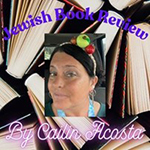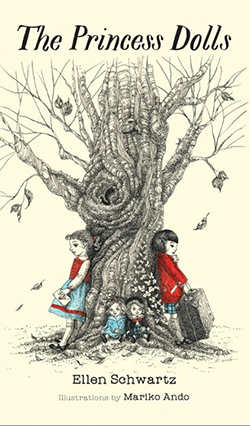The Princess Dolls by Ellen Schwartz and Illustrations by Mariko Ando; Vancouver, Canada: Tradewind Books © 2018; ISBN 9781926-890296; 223 pages; PJ Our Way.

 SAN DIEGO – The year was 1942 and World War II was wreaking havoc across Europe. Best friends Esther Shulman and Michiko Suzuki lived in Canada with their families. Little did they know two princess dolls would start to unravel their friendship.
SAN DIEGO – The year was 1942 and World War II was wreaking havoc across Europe. Best friends Esther Shulman and Michiko Suzuki lived in Canada with their families. Little did they know two princess dolls would start to unravel their friendship.
Esther and Michiko were both born on February 7, 1933, and would make believe they were Princess Elizabeth and Princess Margaret from the United Kingdom. One day they walked past Rafelson’s Toy Shop and their worlds were forever changed. In the window was a Princess Elizabeth doll and Princess Margaret doll. Princess Elizabeth wore tiny white gloves, shiny black pumps and a stylish powder-blue coat. She had a porcelain face and real-looking curled brown hair. Princess Margaret wore a maroon cardigan over a ruffled white blouse and a navy, red and green plaid shirt and shiny black Mary Janes on her feet. The girls asked Mr. Rafelson how much the dolls were, he told them $15 each which was a huge expense in 1942. But it was January, and the girls had about a month to convince their parents to get them for their shared birthdays so they wouldn’t have to make believe anymore.
During this time, Japan had bombed Pearl Harbor in Hawaii and Japanese Canadians were treated harshly. Michiko’s parents’ corner store was forced to close, and Michiko’s father was sent to a work camp. All Japanese Canadians were forced to register as “enemy aliens” even if they were Canadian citizens.
Esther had her birthday party and had to invite her classmate Florence since she was invited to her party. As the party went on and she opened everyone’s gifts, Esther’s Grandma Sadie brought out a large box wrapped in Rafelson Toy Shop paper. All the girls crowded around, except Michiko. Esther had received the Princess Elizabeth doll. All the girls were so excited to touch and hold her, but Michiko sat in the corner not included in the excitement. Later, Esther realized Michiko’s family did not get her the corresponding Princess Margaret doll.
Esther felt terrible that Michiko did not get the Princess Margaret doll so started doing extra chores to help pay for the doll. Florence had her birthday party and her parents had bought her the Princess Margaret doll so they immediately started planning play dates so the dolls could play together.
Michiko was upset and thought Esther had moved on to being best friends with Florence since Esther was spending a lot of time with her. The government had decided to send all Japanese women and children to work camps which included Michiko’s family. The girls said goodbye because their mothers had told them to.
Esther felt terrible her “used to be” best friend was gone and how they had fought over the Princess Elizabeth and Margaret dolls. She mailed Michiko the Princess Elizabeth doll to help comfort Michiko and to say she was sorry.
A few weeks passed and Esther did not get a response that Michiko received the doll or not. Eventually the same Rafelson’s box arrived and looked like it was returned which Esther felt confirmed Michiko was no longer her friend. She opened the box and a note from Michiko thanked Esther for the doll and that she would take good care of her. Under the note was a handmade doll Michiko and her mother made with a striking resemblance to the Princess Margaret doll. The girls had forgiven each other and remained best friends.
The story of Esther and Michiko is a reminder to communicate with each other as it was a miscommunication that Esther was moving onto a friendship with Florence. As Japanese Canadians were being ridiculed, Esther noted that Michiko and she had never argued about being white, Japanese, Jewish or Christian, but they fought over a “stupid doll.”
The setting was based on real events that happened during World War II and the alienation Japanese Canadians dealt with during that time. The illustrations complemented the story. It kept me in suspense hoping Esther and Michiko would one day rekindle their friendship, so I was thrilled to read the “happy ending.” This Young Adult Historical-Fiction book would be perfect for girls ages 9-12 years old.
*
Cailin Acosta is the assistant editor of the San Diego Jewish World.